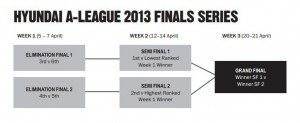 A-League officials have had the golden touch this season.
A-League officials have had the golden touch this season.
Star imports Shinji Ono, Emile Heskey and Alessandro Del Piero have not only lived up to enormous expectations, but also declared their intent to stay in Australia going forward.
Crowds have been encouraging, playing standards appear to have risen sharply, a free-to-air tv rights deal with SBS has been agreed on and the Western Sydney Wanderers have claimed the Premiers Plate in their inaugural season – sparking a new wave of parochial football fans.
Football Federation Australia (FFA) should be highly commended for providing stability and clear direction, as well as a wonderful sporting product. But one very timely query remains – the finals system.
Firstly, let’s consider the current format. The following is the finals structure in 2012/13:
There have been significant adjustments made from the previous structure implemented in 2009/10, when the league expanded from eight to 10 teams.
The 2012/13 changes dictate that every final has an elimination element, a smart commercial move to intensify value and attract interest. The length of the finals series has been reduced from four to three weeks, another savvy decision given that the AFL and NRL seasons are now in the full swing and will dominate much of the sporting market.
However, the removal of the finals double chance for the top two A-League sides has polarised opinions. Central Coast Mariners coach Graham Arnold is displeased with the change – understandable given that his side finished second on the table. By contrast, Melbourne Victory coach Ange Postecoglou believes the new concept adds anticipation and intrigue to the season’s climax.
“In the past you could have an off day if you finished first or second and still get a second bite of the cherry but that doesn’t exist any more which makes it more exciting for everyone,” Postecoglou told Four-Four-Two.
“It’s a little bit more cut and thrust this time around.”
While to some it’s a nicely balanced approach, and grossly disadvantageous to others, there is another angle to consider.
Should six sides be granted a finals spot in a 10-team competition?
On the surface, it’s somewhat farcical that 60% of A-League teams participate in the post-season. Sixth-placed Perth Glory finished just five points above wooden spooners Wellington Phoenix and a whopping 25 points behind the Premiers Plate winning Wanderers, illustrating the gap between the best and the finals bound middle tier.
From an idealistic standpoint, mediocrity should not be rewarded. But there’s a lot more to consider than mere semantics.
With equalization measures such as a $2,478,592 salary cap, the A-League is one of the most tightly contested football leagues in the world.
The margin between success and failure is razor thin, giving each team genuine belief that they will threaten for the title. The environment suggests that it doesn’t hurt to give the likes of Perth a shot at glory, because they are realistically capable of becoming champions.
The six-team finals series is a safe way of ensuring almost every home and away match is guaranteed to influence finals positions. Coming into the closing round of the 27-match regular season, only the Melbourne Heart and Wellington Phoenix were out of finals contention.
Such a scenario is healthy and desirable, particularly on a commercial basis.
So where should the A-League draw the line between providing incentives at the bottom and rewarding those at the top?
A top five finals format could be the answer.
Using the McIntyre system adopted by the VFL/AFL from 1972 – 1990 poses as a subtle shift towards a best of both worlds solution. The system would give the minor premier an added advantage of a week off and leave them just one victory from a grand final spot, while the remaining sides battle out in cut-throat finals.
The A-League remains in a hugely promising but undeniably delicate position, where an overly ambitious attitude could rock the ever strengthening foundations – but that’s not to say that they should rest on their laurels.
You could argue that if it ain’t broke, don’t fix it. There is certainly merit in the top six structure. However, there should always be a pursuit of improvement and perfection. The more the A-League’s commercial graph heads in a skyward direction, the more viable an increasingly stringent finals option becomes.
 Paul Bastin is a third-year Bachelor of Media Studies student at La Trobe University and upstart’s sports editor. You can follow him on Twitter: @PaulBastin10
Paul Bastin is a third-year Bachelor of Media Studies student at La Trobe University and upstart’s sports editor. You can follow him on Twitter: @PaulBastin10







